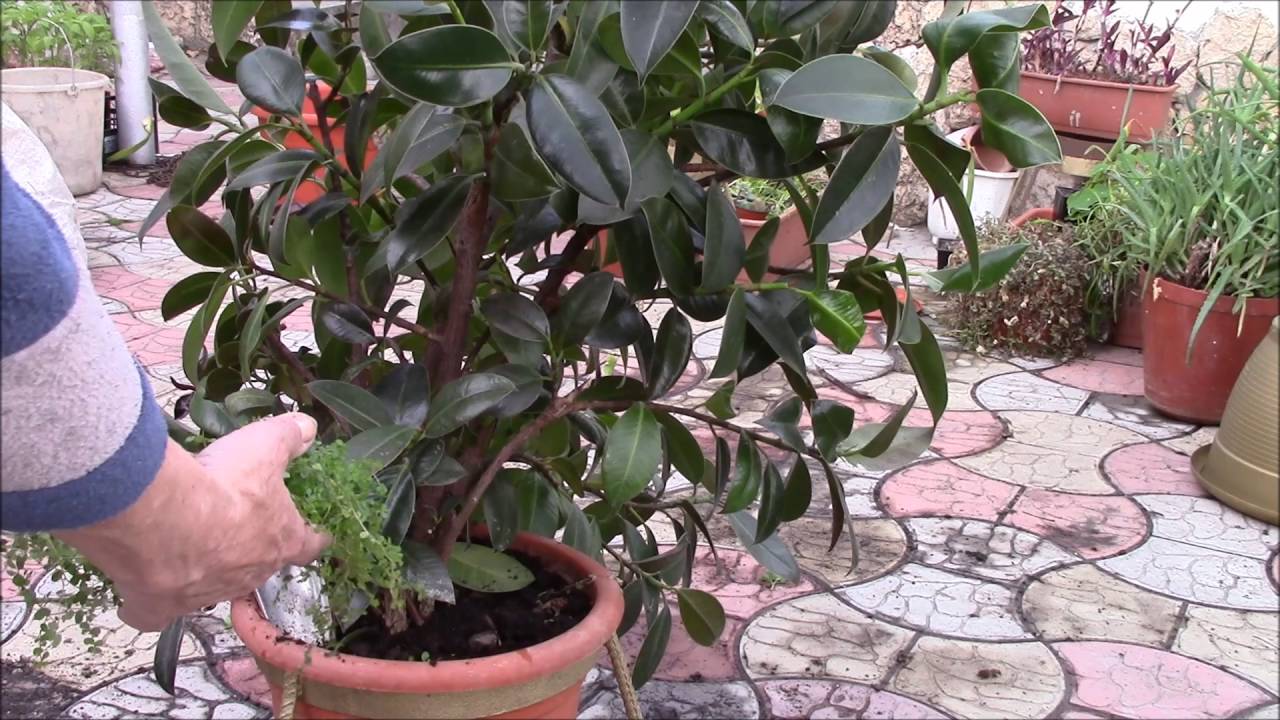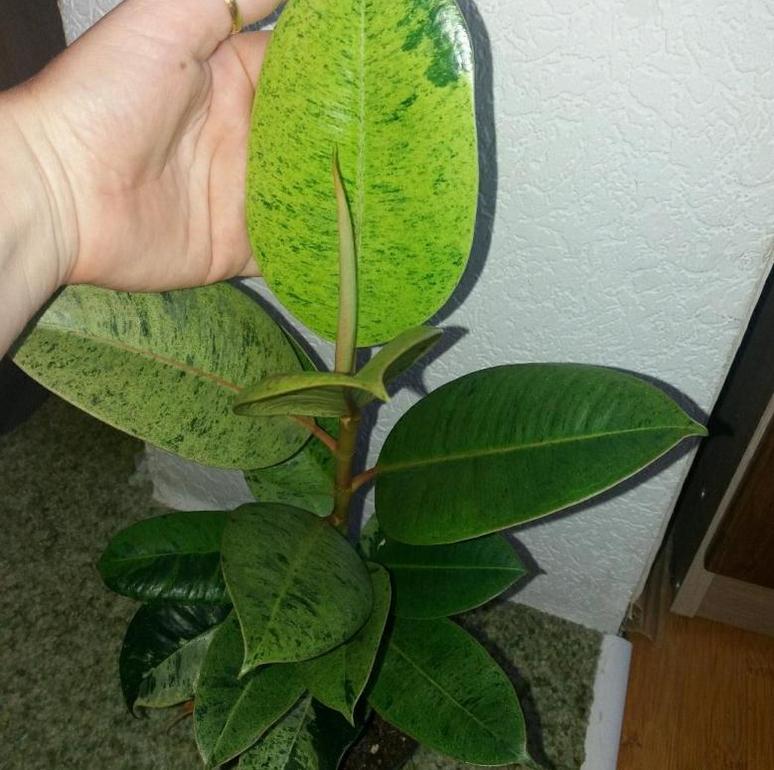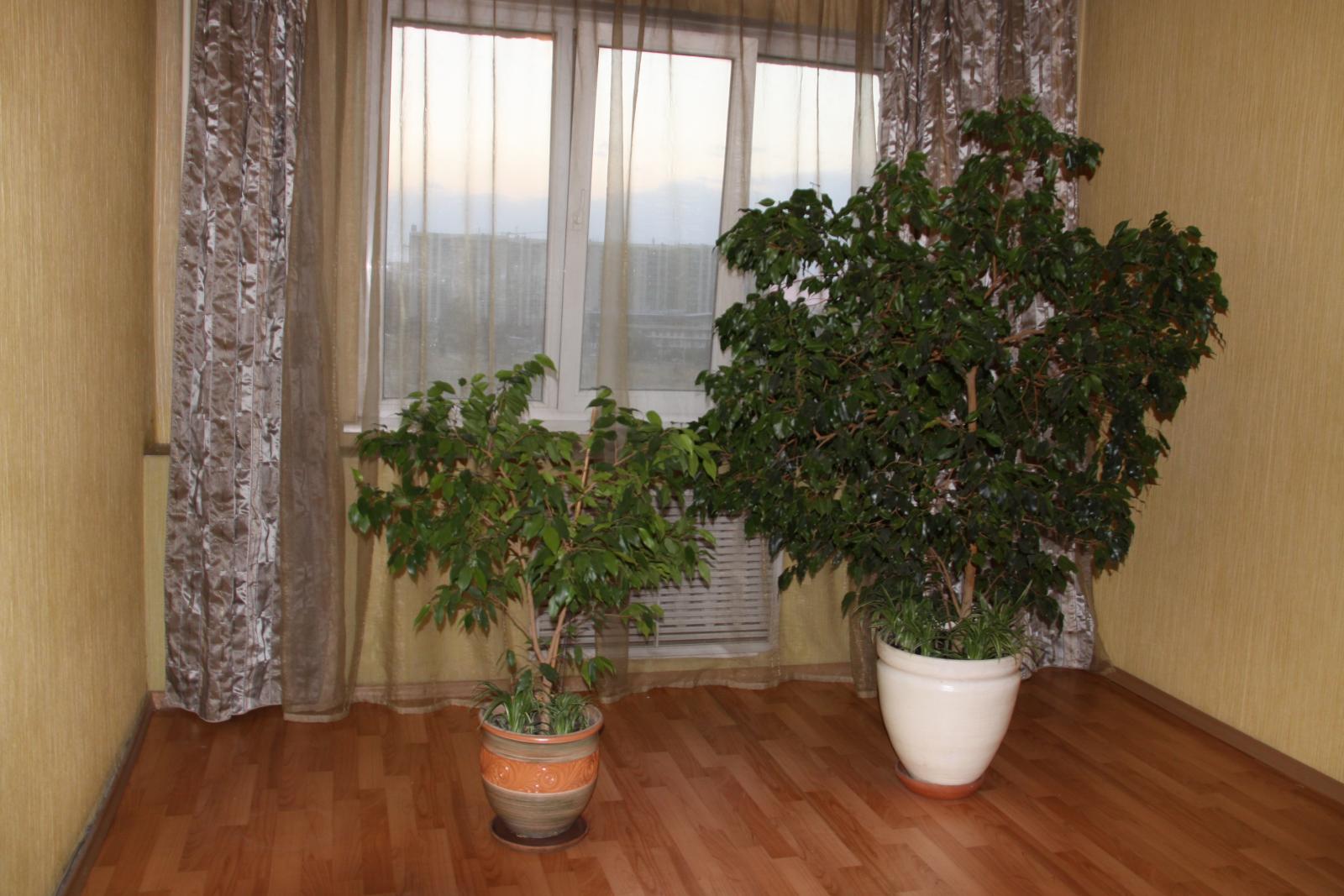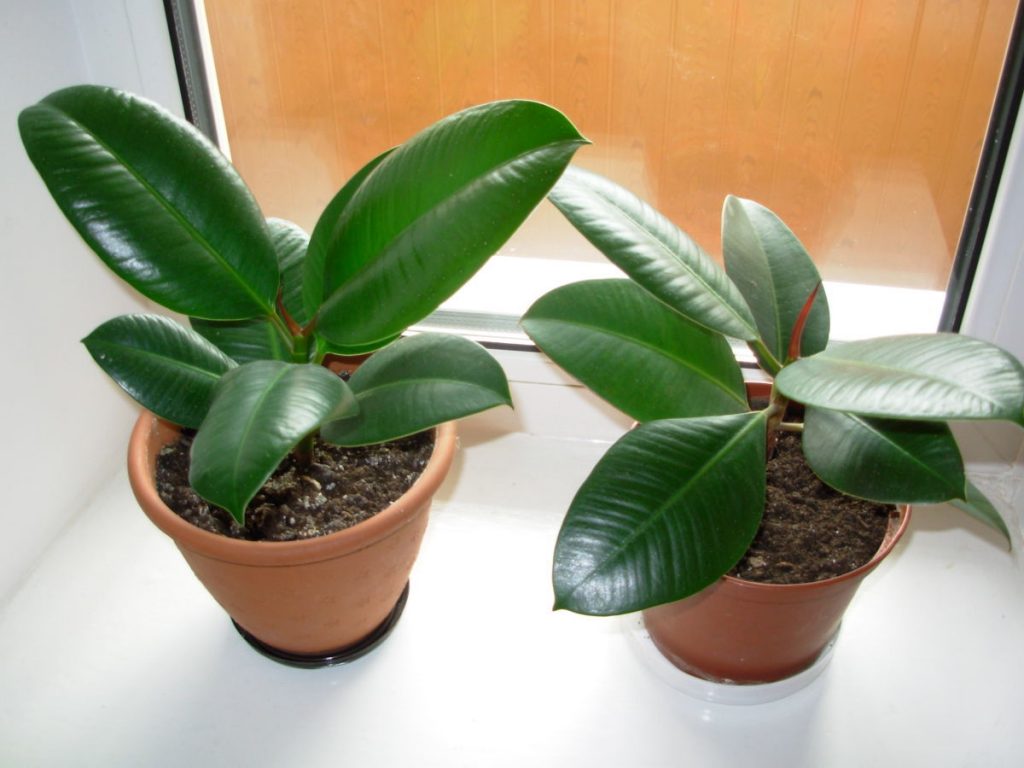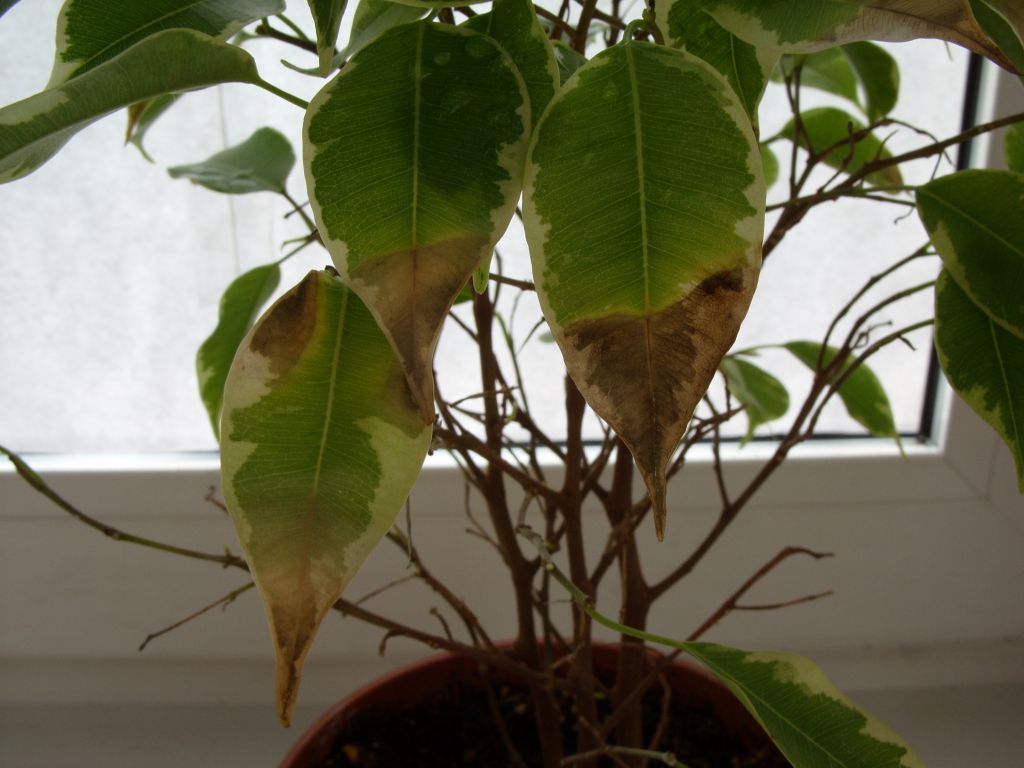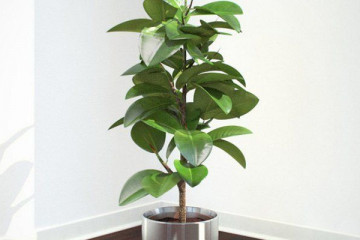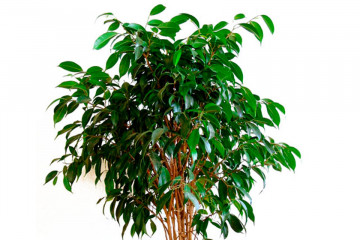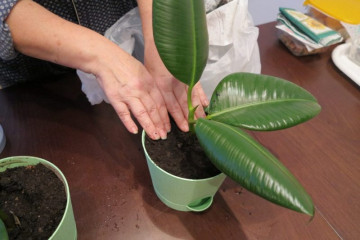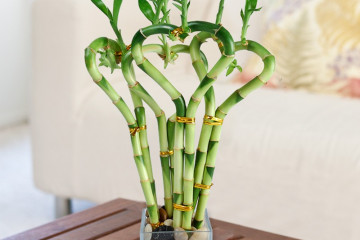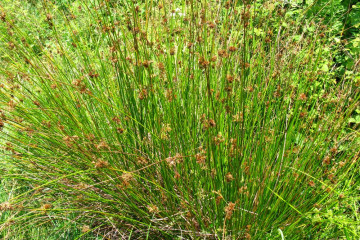Ficus Melanie - home care
Content:
Melanie's ficus variety, or rubbery, was bred quite recently, but it has already gained popularity among many gardeners. With proper care, the plant becomes a real decoration of any home.
What does Ficus Melanie look like, which family does it belong to
This plant is so compact that it is suitable for cultivation in any premises. Melanie's ficus has a beautiful crown. Densely planted leaves give the plant a special appeal.
The length of the leaf plates is about 13 cm. Their surface is glossy, and the reverse side, on the contrary, is matte. Many reddish veins can be seen against the light green background. The vertical version of growing the plant allows you to achieve a lot of branching. Pruning will help give your shrub any shape you want.
Common varieties
The most common varieties of rubbery ficuses are:
- Abidjan - the plant loves bright light, has oval leaves of a dark green color, pointed at the end.
- Belize - a feature of the variety - white and pink streaks along the edges of the leaf plate.
- Melanie - this ficus has dense foliage, the length of the plate is 15 cm.
- Robusta - the variety is the most unpretentious, the leaf length is 30 cm, the shape is ellipsoidal.
- Black Prince - the color of the foliage of this variety is the darkest of all. The leaves are rounded, their hue changes in accordance with the changing light in the room.
- Tineke is a variegated variety, along the edges of the foliage you can see a white or cream border.
- Sriveriana - ellipsoidal foliage has a marble color, the plate is 25 cm long and 18 cm wide.
- Tricolor is a variegated variety, the foliage has an interesting marble pattern.
- Decor - dark green foliage with a burgundy tint, the length of the plate is 18 cm.
Healing properties
The juice of this plant is good for difficult healing wounds and boils. Dry ficus leaves are used in the treatment of rheumatism and hemorrhoids. The leaves are also used in gynecology and oncology. Inflammatory processes are well removed by tincture of plant roots.
Briefly about the history of appearance
In one of the greenhouses in Holland, which is considered the birthplace of the plant, an interesting bush appeared, which mutated completely independently from the ficus elastica Decor. Scientists took cuttings for rooting. After reproduction, an excellent hybrid turned out, which retained the characteristics of the mother bush in full. It so happened to highlight a new variety, which was given the name Melanie.
Ficus Melanie: home care
The flower is not very picky about care. Many errors in plant maintenance go unnoticed, but the main points of cultivation should not be completely ignored.
Temperature
A good temperature range for Melanie is considered to be 18-30 degrees Celsius. The plant may die if the thermometer in the room drops to 12 degrees. The ideal temperature is 20-25 degrees Celsius.
Lighting
Ficus elastica Melanie does not tolerate direct sunlight, lighting should be diffused. The ideal windows for growing a plant are western or eastern windows. In winter, the bush may need additional artificial lighting. If there is not enough light, the leaves will begin to fall off. With an excess of light and direct sunlight, burns will appear on the sheet plates.
Watering
For this variety, rare watering is preferable than abundant watering. There is no specific humidification schedule. It is better to focus on the state of the earth in a pot. The soil should be dry, but it should not be allowed to dry out and crack. Watering should be carried out when the earth has dried out to a thickness of 5 cm. In the summer season, several waterings per week are required, and in winter, 1 watering every 10 days is enough.
Spraying
If the temperature in the room is higher than the recommended one or the air in the house is too dry, you need to periodically spray the ficus. To moisten the crown, only cool, settled water (no more than 10 degrees) is suitable.
Humidity
The air where Melanie grows must be humidified. This plant does not tolerate dryness indoors. You can wipe the leaves daily, do a shower once a month. Frequent spraying will help humidify the air.
Priming
Experienced flower growers do not make soil with their own hands, but buy ready-made compositions for ficuses. If there is no opportunity to purchase soil, you need to make the appropriate soil for the flower at home:
- slightly acidic or sour;
- moisture permeable;
- breathable.
When preparing the soil, you need to mix 1 part of leafy soil, 1 part of turf, 1 part of humus and half of river sand. Expanded clay or broken brick is used as drainage.
Top dressing
During the growing season and active growth, the plant requires several dressings per week. Fertilizer can be used in the form of nettle broth, wood ash or mineral formulations in liquid form. Top dressing can only be applied to wet soil, preferably with watering or the next day after it. Further feeding will be needed only a few times a year (1 time - in warm weather and 1 time - in cold weather).
Features of care in winter, dormant period
Almost every ficus with a decrease in temperature and a lack of light goes into the sleep stage. If the optimal temperature regime is observed in the room, that is, when the apartment is well heated, the growth of the plant can continue. In this case, you need to use artificial lighting and monitor the humidity of the air. If these conditions are not met, Melanie's rubber ficus will enter the stage of rest and sleep. In this case, he will shed the leaves. It will only be necessary to maintain a cool temperature and occasionally water the plant, about 1 time per month.
Pruning
The ficus of this variety sheds the lower leaves during the ripening process. To maintain high decorativeness, formative pruning is carried out at the end of winter. For good branching, you need to cut off the top of the ficus, and to increase the splendor of the shrub, about five upper internodes are cut off.
An additional way to get a beautiful crown is to press the ficus as low as possible to the ground. In this case, not the apex, but the lateral kidney will become the main one. She will begin her active growth.
How Ficus Melanie reproduces
All ficuses are actively multiplying, and Melanie is no exception.
Germinating seeds
At home, the ficus Elastica Melanie does not bloom, for this reason, propagation of a shrub using seeds is impossible.
Rooting cuttings
Cuttings are harvested in the spring, but you can do this in the summer.You need to cut off the top or side shoots. To make the cut take root faster, it is treated with Kornevin. You can root the stalk not only in the ground, but also in water.
Air layering
Cuts are made on the trunk and fix it with a sliver. Moss is wound around the incision and fixed with a film. After a month, the roots will appear, and then the stalk can already be cut and placed in the ground.
Transfer
At a young age, ficus is transplanted at least once a year. An adult plant needs a transplant once every 3 years. To understand when to transplant ficus, you should pay attention to the roots. If they grow through the drainage holes of the pot, then the container is completely filled with the root system. The transplant is carried out in the spring, using the method of transferring from a pot to another container along with an earthen lump. The remaining free space is filled with soil.
Possible growing problems and diseases
Ficus Melanie, although it has a high resistance to many diseases, but problems with its cultivation can still arise if it is not looked after.
Drops buds and leaves
The reason for this condition is violations of the rules of care. Most likely, ficus was either too flooded with water, or irrigation was carried out infrequently. To fix the problem, you need to take care of the drainage layer and irrigate regularly.
Leaves turn pale
Foliage can turn pale due to a lack of nutrients in the soil. In this case, the ficus must be urgently fed or wait for the period when the plant can be fertilized without threatening its development.
The tips of the leaves dry
This is due to the increased dryness of the air. A container of water placed next to the pot will help solve the problem. It is important to carry out frequent spraying and moistening of the soil. It is useful to wipe the leaves with a damp cloth.
The lower leaves fall
When the ficus sheds the lower leaves, this does not mean that there are problems. Thus, the plant is simply renewed. When the lower foliage falls, a new top grows.
Pests
The most popular pests of ficus are thrips, spider mites and scale insects. Insects can be collected and destroyed by hand, or special preparations can be used to eliminate the likelihood of larvae.
Other problems
If the leaves of the ficus plant become dark and damp, this could be a sign of root rot. Most likely, the ficus was waterlogged. Excess watering needs to be eliminated, but in most cases it is not possible to save the bush.
Signs and superstitions
The Slavs have long believed that the ficus in the house contributes to the development in the owners of such traits as envy, scandalousness and a tendency to gossip. There is also an opinion that ficuses drive away a potential husband from a woman and do not allow him to get along in the house. Foreigners believe that this bush strengthens the family and has a beneficial effect on the atmosphere in the house.
Ficus Melanie is very popular among novice flower growers and experienced connoisseurs of such decorative crops. Unpretentious care and cultivation characterize the bush only on the positive side.
